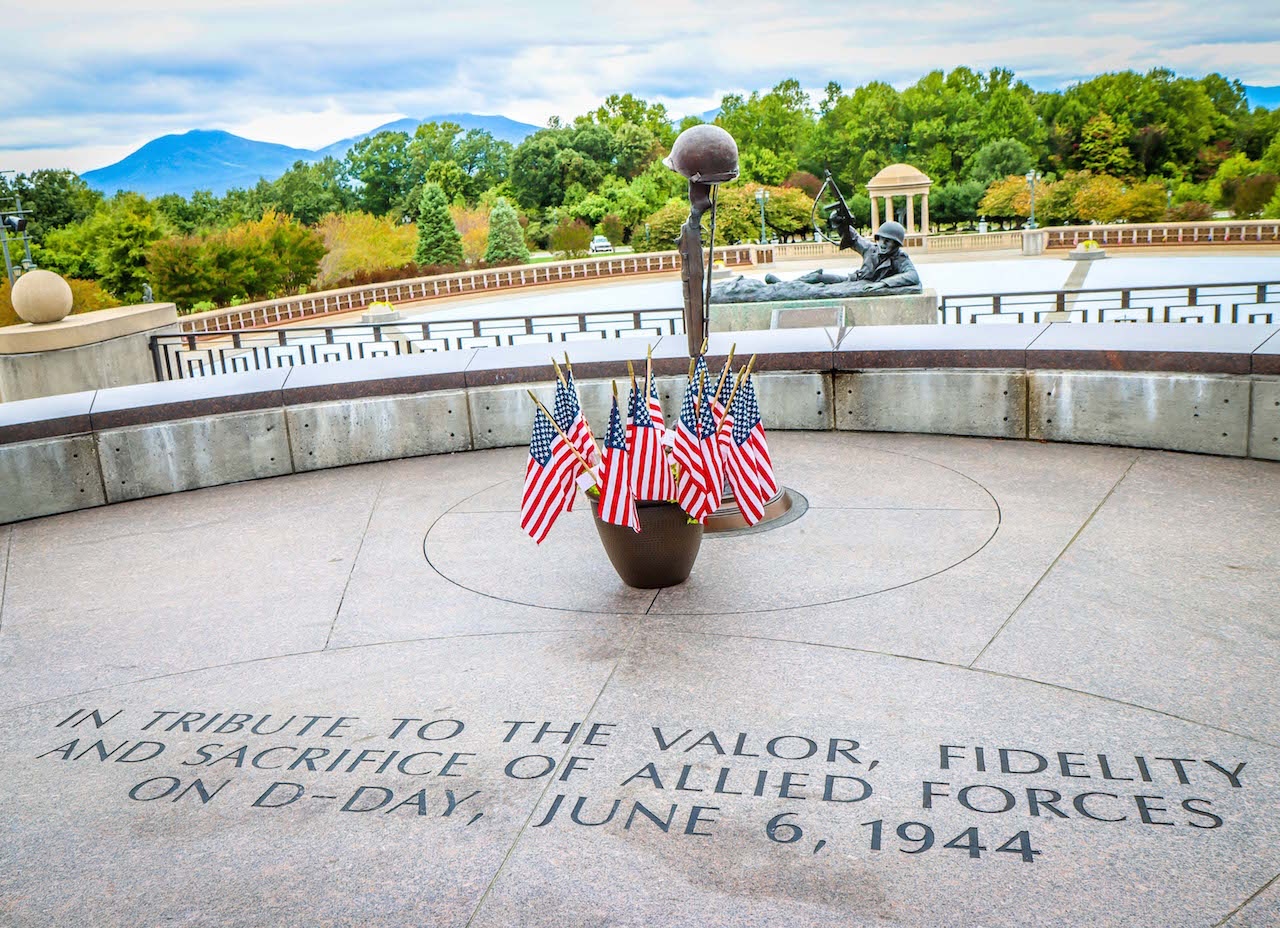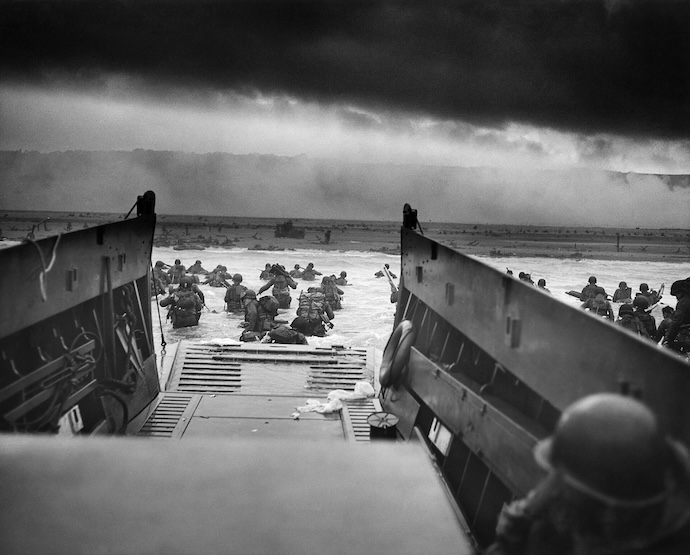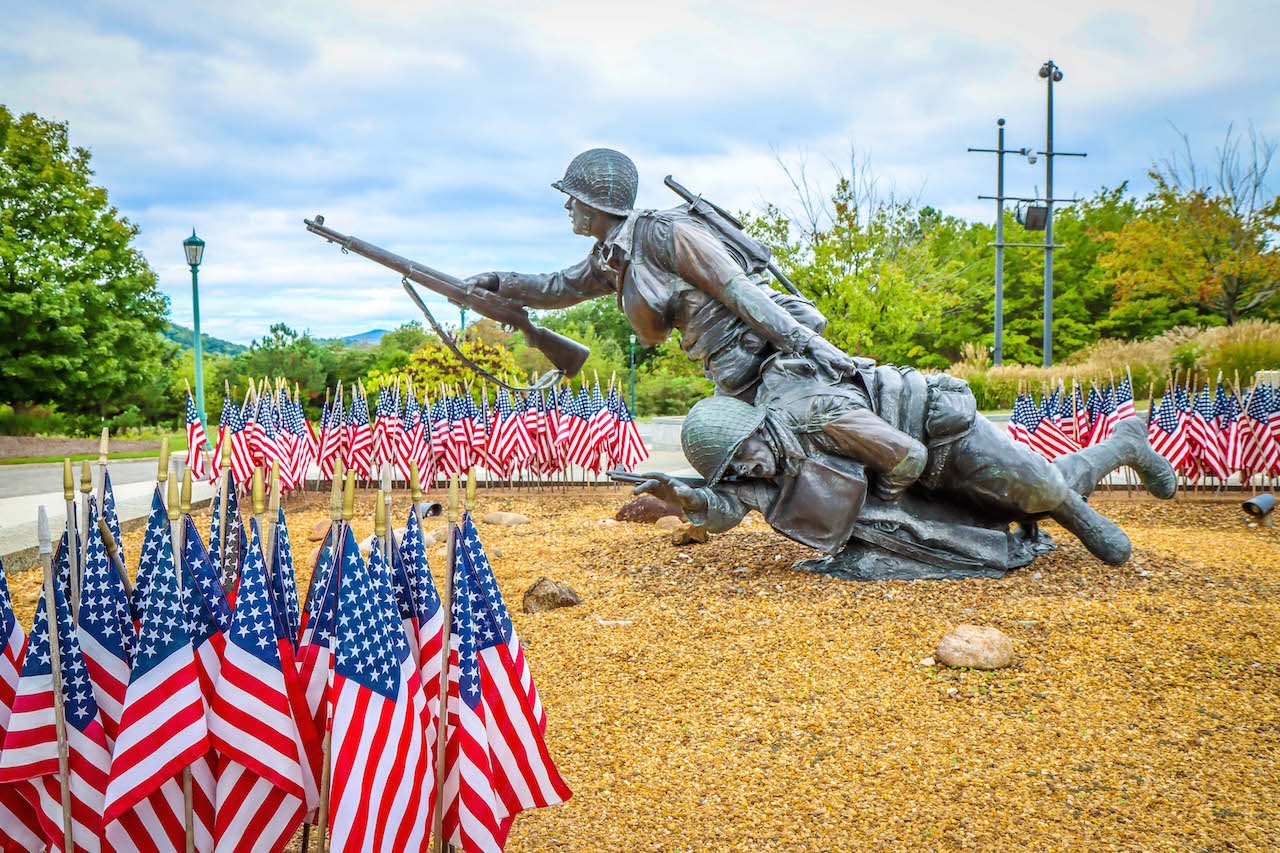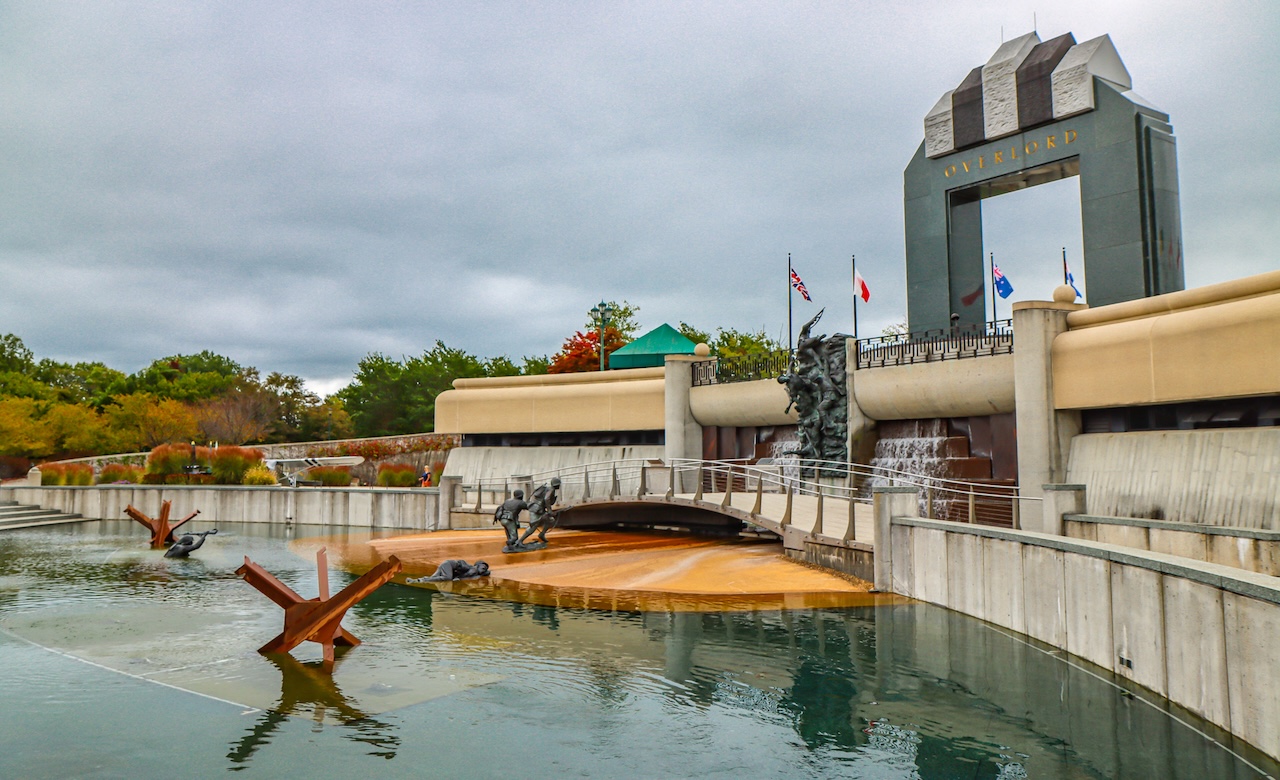If you visit Bedford VA (located about 28 miles east of Roanoke), you won’t get far before you realize how much of an impact World War II had on this charming small town.
Bordered by the Blue Ridge Mountains to the north and Smith Mountain Lake to the south, the town dates back more than 240 years, to its founding as the village of Liberty in 1782.
But as you’ll quickly come to realize (if you’re not already a huge WWII buff), the single most important day in Bedford VA history was June 6, 1944, more commonly known as D-Day.
You’ll learn about the town’s connection to the Allied invasion of Normandy via a video at the Bedford Area Welcome Center, an exhibit at the Bedford Museum, and/or at the Bedford Boys Tribute Center.
But if you really want to gain a deeper understanding of what happened on that historic day, and how it inexorably affected this beloved Blue Ridge Mountain town, you simply must visit the National D-Day Memorial.
Read on for our in-depth guide to visiting this historic landmark, including hours, ticket prices, driving directions, and details on the powerful tributes you’ll see there.
READ MORE: The 10 Best Things to Do in Bedford VA

National D-Day Memorial Info
ADDRESS: 3 Overlord Circle, Bedford VA 24523
PHONE: (540)586-3329
HOURS: Open daily 10AM to 5PM during peak season. Closed Mondays December through February.
ADMISSION: Adults $15; Veterans (not WWII) $10; Students (ages 6-18 or college ID) $10; Children 6 & under FREE; WWII Veterans & Active-duty Military FREE. Thomas Jefferson’s Poplar Forest Combo Ticket $30, which
includes admission and tour (when available) at both sites.
DRIVING DIRECTIONS FROM DOWNTOWN BEDFORD
From Downtown Bedford, take West Main St, then make a left on Crenshaw St, which turns into Burks Hill Rd.
In 1 mile, make a right onto Tiger Trail, which becomes Overlord Circle. The Memorial is at the circle’s center.
DRIVING DIRECTIONS FROM ROANOKE
From Downtown Roanoke, follow US-221 N/US-460 east for about 26.6 miles, then get off at the VA-122 exit.
Take a left onto Burks Hill Rd and proceed through the stoplight, then take a left onto Tiger Trail, which becomes Overlord Circle.
READ MORE: The 15 Best Things to Do in Roanoke VA

The Bedford Boys/D-Day History
Launched on June 6, 1944 (a.k.a. D-Day), Operation Overlord was the code name for the Battle of Normandy, which ultimately led to the successful liberation of Nazi-occupied Western Europe during World War II.
It was the largest seaborne invasion in military history, with a 1,200-plane assault by air, a 5,000-vessel assault by sea, nearly 160,000 Allied troops crossing the English Channel on D-Day, and over 2 million Allied troops on the ground in France by the end of August 1944.
The Normandy invasion began shortly after midnight, with relentless bombardment on the German troops by air and by sea. Amphibious landings on the coast of France began at 6:30AM, with a targeted 50-mile stretch of beaches divided into 5 sections, nicknamed Utah, Omaha, Gold, Juno, and Sword.
Allied troops landed on D-Day under horrendous conditions. They took extremely intense fire from strategically positioned Nazi gun emplacements. The beaches were heavily mined and covered with wooden stakes, barbed wire, and other obstacles, making them difficult (and dangerous) to clear.
Those that managed to survive the Normandy landing still had to fight their way up high cliffs, then make their way through heavily fortified towns, often fighting house-to-house.

By the end of the day there were 10,000+ Allied casualties, with 4,427 confirmed dead. Soldiers from the 29th Infantry Division were among the first to hit the beach, immediately coming under heavy fire from German troops.
Company A, from the 116th Infantry Regiment of the Virginia National Guard in Bedford, was almost completely annihilated upon their arrival at Omaha Beach, where Allied forces suffered their greatest losses.
Of the 34 VA National Guard soldiers who were in Company A, 19 were killed in battle on D-Day, while 4 more died later in the Normandy campaign.
Coming from a small Virginia mountain town whose total 1944 population was around 3,200, the community of Bedford VA proportionally suffered America’s most severe D-Day losses.
The lives and deaths of these young men from Bedford were chronicled by British journalist Alex Kershaw in his 2003 bestseller,
READ MORE: 30 Facts About Appalachian Scots-Irish History & Culture

National D-Day Memorial History
The concept for the National D-Day Memorial began in 1988, with a small committee led by D-Day veteran Bob Slaughter, which later became the non-profit National D-Day Memorial Foundation.
But financial support for completing the attraction didn’t coalesce until the 50th anniversary of the Normandy invasion in 1994. That’s when the town of Bedford donated 11 acres of acres of land for the memorial, then the foundation purchased additional acreage to bring the total size to 50+ acres.
Director Steven Spielberg was an early donor, including funding the Arnold M. Spielberg Theater in honor of his father, a World War II veteran.
Peanuts creator Charles Schulz also donated $1 million, and he and his wife volunteered to head a major fundraising campaign for the memorial.
The United States Congress officially declared that this would be the nation’s D-Day Memorial, which was authorized by President Bill Clinton in September 1996.
Hundreds of people, including D-Day and World War II veterans, gathered for the Bedford attraction’s groundbreaking ceremony on Veterans Day in 1997.
The ground the Memorial would be built on was consecrated with a mixture of sand from the coast of Normandy and Bedford soil.
The National D-Day Memorial was dedicated to those who died in the bloody battle by President George W. Bush on June 6, 2001, the 57th anniversary of D-Day, with founder Bob Slaughter standing proudly beside him.
READ MORE: The 10 Best Blue Ridge Parkway Museums to Visit
Exploring the National D-Day Memorial

Reynolds Garden
Attracting tens of thousands of visitors each year, the National D-Day Memorial was designed to have three distinct plazas, each of which follows the timeline of Operation Overlord.
The first of these, the Richard S. Reynolds Sr. Garden, was designed in the shape of the Supreme Headquarters Allied Expeditionary Force (SHAEF) combat patch, and honors those involved in planning and preparing for the invasion.
In addition to landscaping with gorgeous native Virginia flowers and trees, the garden also features a walking path, gazebo, and a plaque honoring Reynolds, an industrialist who led the American aluminum industry during WWII.
He was also a poet, and the plaque features a stanza from his most famous poem, “An American Credo”:
I abhor the beaten path. Not for me
The cowbell or the curfew. I shun
The smooth highroad strung
With signs of warning and safety signals.
I dare the darkness to reach the dawn.
READ MORE: Visiting the Peaks of Otter Lodge & Campground in Bedford VA

Gray Plaza
The second (and, for us, most personally impactful) level of the Memorial was designed to reflect the beach landing at Normandy and the fighting stages of the invasion.
At its center is the stunning “Invasion Pool,” which powerfully brings D-Day to life in what can only be described as a spiritually and emotionally moving sensory experience.
Lifelike sculptures of soldiers appear to move through the water with rifle held aloft, struggle to their feet as they reach the shore, and help each other ascend the wall at Omaha Beach, as one lays dead on the shore.
There are obstacles strewn in the water, a representation of the Higgins boats used in the landing, and intermittent jets of water bursting out of the pool as the sounds of gunfire rat-a-tat all around you. I was overwhelmed.
The pool is surrounded by the Necrology Wall, which attempts to honor every single Allied soldier, sailor, airman, and coastguardsman killed on D-day by name. All United States losses appear on the west wall, with other Allied losses on the east wall.
READ MORE: The 10 Best Civil War Battlefields in Virginia to Visit

Estes Plaza
The final and uppermost section of the National D-Day Memorial celebrates the Allied victory in World War II.
Its features include more statues of soldiers, flags of the 12 nations that served in the Allied Expeditionary Force, and an inscription that reads, “In tribute to the valor, fidelity and sacrifice of Allied Forces on D-Day, June 6, 1944.”
But the most iconic feature of this section is the massive Overlord Arch, which represents the victory of Operation Overlord. It bears the date of the D-Day invasion in its height of 44 feet and 6 inches.
To get more of a sense of how the tragic losses of that day impacted the town of Bedford, check out the Bedford Boys Homefront Tour.
This walking tour starts at the D-Day Memorial and moves into Downtown Bedford, whose Victorian and classical Revival-style buildings remain much the same as it was when the Bedford Boys were enlisting, never knowing they’d be part of the largest invasion in military history. –by Bret Love; all photos by Bret Love & Mary Gabbett unless otherwise noted


